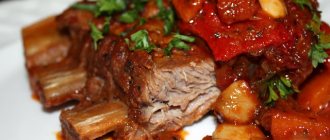Hot chili sauce can be found in almost any cuisine in the world, but it is especially common in Latin America and Asian countries. The most famous are the Thai and Mexican types of this liquid seasoning. It is universal, suitable for dishes of meat and fish, vegetables and legumes. Any snack with it acquires a richer taste and aroma. Chili sauce is not only tasty, but also healthy. It is based on pepper, rich in vitamins and a unique substance - capsaicin, which makes it so hot. This liquid seasoning is not in short supply, but it is not always possible to find a truly high-quality product on the shelves. It's much better to cook it yourself.
Cooking features
There is no single recipe for chili sauce; different countries prepare it using their own technology. Many chefs add something of their own to its recipe, thanks to which the seasoning acquires unique notes. But despite all the differences, the technology for preparing hot liquid seasoning has common features. It is necessary to know some of these points if you want the result not to disappoint.
- Chili peppers have a particularly spicy taste. If you are not used to hot seasonings, it is better to choose a recipe that contains relatively little of this product.
- The hottest parts of the pepper are the membranes and seeds. Before preparing the sauce, the pepper is processed by removing the seeds.
- If you do not protect your hands with gloves when working with pepper, you can get burned. The same applies to working with garlic if it is included in the recipe.
- Chili sauce can be prepared for future use: it can be stored in the refrigerator for up to 6 months. However, for this purpose the container must be sterilized. Please note that only those seasonings that contain vinegar are suitable for long-term storage.
- If you want to preserve the maximum beneficial properties of pepper, you should not subject it to prolonged heat treatment.
Chili sauce can be served cold or hot. In the latter case, it will be especially hot and not everyone will like it, this must be taken into account. It is advisable to offer the seasoning to guests after cooling it first.
Tabasco sauce: composition and recipe
One of the most popular hot sauces in the world is Tabasco. In its production, the pulp of ripe vinegar and salt are used. Classic Tabasco is aged for 3 years in oak barrels. It has a sour, spicy aroma and a rich, spicy taste. The sauce should be added literally drop by drop to dishes, it is so hot.
At home, Tabasco sauce can be prepared from any sauce, but it is advisable to use cayenne or at least chili. This way the sauce will taste more like the original version.
Before working with pepper, you need to put on gloves on your hands. After this, wash the pepper, cut it in half and remove the seeds. You will only need its pulp, but only if you do not want to prepare an overly hot and spicy version. In addition, you need to take some water, 50 ml of apple or white vinegar (wine), and salt to taste. Place all ingredients in a blender and blend well until smooth. Adjust the amount of water to your taste. If desired, the finished sauce can be rubbed through a fine sieve.
According to the W. Scoville scale, the hottest Tabasco sauce in the world is “Habanero” (Tabasco Habanero), the heat of which is 7-9 thousand units. At the same time, the heat of classic red Tabasco sauce is 2500-5000 units, and green sauce - from 600 to 1200 units.
The most common chili sauce recipe
Compound:
- chili pepper – 0.35 kg;
- garlic – 2 heads;
- wine or apple cider vinegar (6 percent) – 60 ml;
- sugar – 60 g;
- starch (optional) – 10 g;
- vegetable oil (optional) – 10 ml;
- allspice peas – 5 pcs.;
- salt – 10 g.
Cooking method:
- Wash the peppers, cut off the tails of the pods. Cut the peppers in half and remove the seeds. Finely chop two pieces, grind the rest in a blender until pureed.
- Using the same device, puree the peeled garlic.
- Grind allspice using a special mill.
- Combine pepper puree with garlic and pepper pieces, add salt, sugar, vinegar. If you are worried that the sauce will burn during heat treatment, add 1-2 teaspoons of vegetable oil.
- Cook for 5 minutes over low heat. You need to time it after the sauce starts to boil.
- If you want a thicker consistency, dilute the starch with a tablespoon of water, pour into the main mixture and cook for another 5 minutes.
If you want to serve the sauce for a later dinner, try to cool it quickly by placing the saucepan on ice and then storing the sauce in the refrigerator. For long-term storage, the seasoning should be poured into glass bottles or jars, having previously sterilized them.
Moderately hot sauce made from two types of peppers
Hi all! The recipe is dedicated to lovers of spicy and not so spicy sauces. Another variation of my “soudzhika”, with some amendments. We will need
: - Chili pepper 4 kg. — Mild hot pepper, for example — “Thunder F1” 1.5 kg. — Salt for pickling without additives 3 tbsp. l. with a slide. - Sugar 2 tbsp. l. — Table vinegar 6% 400 ml. - Ground cayenne pepper 3 tbsp. l. - Starch (optional).
A little introductory text. For some time now I have become interested in preparing hot sauces using the fermentation method. What is fermentation? First of all, this is a method that allows you to store the finished product for a long time. It is the decomposition of products by microorganisms (enzymes), lactic acid bacteria convert carbohydrates in pepper into acid, which in turn preserves the product from spoilage. But that’s not all; as a result of fermentation, the finished product is more saturated with vitamins than fresh pepper and the taste characteristics change.
In the photo I have a jalapeno pepper on my windowsill, thanks to Igor Ovimu for the seeds!
This is what we have, the pepper has not yet been washed or processed.
We wash the chili, cut off the stalk, weigh it and put it in a deep container.
Cut large, mildly hot ones into 3-4 pieces and remove the core; you don’t need to do this with chili.
We scroll through the fine grate of the meat grinder; it is better to put a glove on your hand so that there are no surprises later.
When the entire volume has been processed, add 3 tbsp salt. l., sugar 2 tbsp. l.
Ground cayenne 3 tbsp. l.
Mix thoroughly, close tightly with a lid and put in a cool, dark place for 2-3 days.
After 2-3 days, and sometimes later, you can see the beginning of the fermentation process, juice is released and the mixture separates. It is imperative to check that the brine completely covers the top layer, otherwise mold may form. If the brine has formed only from below, it is necessary to apply pressure. But I have never had such a situation. The most active fermentation process lasts 1-2 weeks, I leave it fixed for 10 days.
After 10 days, stir the mixture and see that the reaction has slowed down significantly, the bubbles are small. That's enough for us.
By this time, this is what the jalapeños had become. New ones also hatched on the balcony.
Make a homogeneous puree from the mixture using an immersion blender.
We rub the mixture through a metal sieve, put the seeds and other dry residue into a separate jar, in the future you can add it to various dishes or use it as a component of a marinade.
Pour the resulting sauce into pans, add vinegar and bring to a slow boil.
This stage is needed to add thickness. A couple of tablespoons of starch in a glass of water, stir and gradually add to the gurgling puree. The degree of thickness is determined by the amount of starch. This step is not necessary, I do both.
At the end, we roll it into a pre-sterilized container and store it in the refrigerator. Opened sauce should preferably be consumed within a month; closed sauce can be stored with virtually no restrictions. Thank you for attention!
Sweet chili sauce
Compound:
- garlic – 2 cloves;
- chili pepper – 60 g;
- starch – 20 g;
- water – 100 ml;
- sugar – 50 g;
- mirin rice wine (can be replaced with semi-sweet white wine or sherry) – 50 ml;
- salt – 5 g.
Cooking method:
- Peel the garlic and pepper. Process individually in a blender. You can use a special press to grind garlic.
- Add sugar and salt to the pepper puree, pour in wine and 50 ml of water.
- Place over low heat and cook for 5 minutes, stirring.
- Add garlic, stir.
- Dilute the starch with the remaining water, pour into the seasoning simmering on the fire, cook for another 3 minutes, stirring constantly.
What is it, description
This is a boiled or raw mixture of crushed chili, seasoned with salt, sugar and doused with weak (up to 6%) vinegar. Unlike regular hot sauce, chili sauce (recipe) can include many other products besides pepper. Depending on the country and region, this may include fermented soy and rice pastes, ground tomatoes, ready-made tomato or banana ketchup, soy sauce, shrimp and fish pastes, vegetable oils, garlic, ginger, savory, citrus zest and other spices.
This seasoning gets its name from the type of pepper of the same name, which is part of the composition and gives it that same taste and aroma. Chili pepper sauce is included in the traditional cuisines of East, Southeast and South Asia, as well as the Middle East and Latin America. It is very different, even within one country there can be 3-5 “traditional” recipes, radically different in the set of ingredients and the method of their preparation.
What dishes does it go with?
In short - to anyone. There are many dishes with which you can eat chili and in the preparation of which it can participate. This sauce is used to flavor fried and baked meats, grilled meats, sausages, seafood, and fish. But a Russian person can easily afford (and will not regret it, believe me!) to eat a beef cutlet with chili.
Hot chili sauce is added during cooking:
- Spicy Asian seafood and fish soups.
- Spicy thick Mexican stew with meat. A prime example is Mexican chili con carne.
- Vegetable side dishes.
- Stewed meat and poultry.
The appropriate type of sauce is selected based on its composition.
About taste and consistency
As we have already said, this seasoning is present in the cuisines of different countries and everywhere they have their own “traditional” recipes. We won’t even try to list them - it’s simply impossible in one article. Instead, we will give general descriptions for the five main varieties of chili sauce in existence:
- Thick salty based on fermented soybean paste, simple and spicy, which, in addition to chili, may include garlic, ginger, fish, seafood, etc. (Chinese Dou ban, Guilin and XO sauce).
- Paste is a chili sauce made from ground chili peppers. Thick, sweet and spicy. For example: Laotian Jeow (Jaew) Bong and Indonesian Sambal with garlic, galangal (a relative of ginger), shrimp paste or fish sauce; Korean Gochujang made with fermented rice flour and soybean paste, with the addition of savory and some other seasonings. Also, one cannot ignore the Maghreb Harissa - a paste of baked peppers with a lot of spicy spices.
- Chili oil. Vegetable oil or a mixture of oils infused with chili peppers, with the addition of garlic and other spices (Japanese La Yu chili, Chinese Làjiaoyóu, etc.). Varying degrees of pungency, with a bright aroma and practically no pronounced salty or sweet taste. Typical for different countries.
- Sweet, sour, spicy chili dipping sauces, medium thick to fairly thin (Filipino agre dulce). In addition to chili, the composition includes banana or tomato ketchup, sugar and salt.
- Salty sweet chili sauce for dipping. Varieties are prepared using soy sauce, garlic, brown sugar, sometimes shrimp paste or other seafood (Filipino siomai and manong, Thai spicy nam phrik).
Please note: pure chili paste is not a sauce on its own, but a possible ingredient for creating one. Therefore, we did not include it in the list and do not mention it further in the article.
We also recommend: Grape vinegar
Chili sauce with tomatoes
Compound:
- chili pepper – 0.2 kg;
- garlic – 10 cloves;
- tomatoes – 0.5 kg;
- onions – 50 g;
- vegetable oil – 80 ml;
- sugar – 60 g;
- lime or lemon juice – 80 ml;
- salt - to taste.
Cooking method:
- Remove seeds from pepper and grind in a blender.
- Peel the onion and garlic and cut into small pieces.
- Pour boiling water over the tomatoes and remove the skins. Cut out the seal near the stem. Cut into large pieces. Blend in a blender and pass through a sieve to remove the seeds.
- Mix tomato puree with pepper, add salt, sugar, mix.
- Heat the oil in a frying pan, fry the onion and garlic in it until golden brown.
- Pour in vegetable puree and simmer for 10 minutes.
- Add citrus juice, stir, simmer for another 2-3 minutes.
The sauce prepared according to this recipe turns out to be less spicy than that made according to previous recipes, but it cannot be stored for long periods of time. This seasoning must be consumed within a maximum of 2 weeks, but it is better to do so within a week.
Sweet chili sauce: what is it?
Sweet chili with vegetables and rice
What is the famous Thai sweet chili sauce? This is a sauce based on Chilean hot peppers, which is complemented by the sweetness of honey or cane sugar. It has a soft scarlet color and slight transparency. An airy, watery consistency; sometimes there are grains of chili pepper or tomato in it.
Thai chili tastes sweet and spicy at the same time, with a pleasant tomato undertone. The spiciness can be different, it all depends on the personal tastes of the one who cooks or who is going to try it. It has a basic composition, but in many countries, and simply in different kitchens, they can prepare it slightly differently. For example, someone doesn’t like garlic, but someone else wants to season the taste with mustard or horseradish, or add an apple... No problem! You can add new ingredients to this sauce and look for new flavors. Homemade sweet chili is a tasty and healthy product that goes with all dishes and can become a permanent addition to the table.
Chili sauce with tomatoes and bell peppers
Compound:
- chili pepper – 100 g;
- bell pepper – 0.4 kg;
- tomatoes – 0.3 kg;
- vegetable or meat broth - 0.25 l;
- sugar – 5 g;
- dried oregano (oregano) – 5 g;
- garlic – 2 cloves;
- tomato paste – 40 ml.
Cooking method:
- Bake the garlic, bell peppers and tomatoes for an hour in the oven, cool, peel, grind in a blender and rub through a sieve.
- Clean and grind the chili peppers using a blender. Mix the resulting puree with the vegetable mixture.
- Dilute the tomato paste with broth or water, pour into the vegetables, and whisk.
- Add sugar and oregano, stir.
- Pour into a saucepan and place on low heat. Simmer for 15–20 minutes. During this time the seasoning will become thicker.
Recipe Sweet Chili Sauce Thai. Calorie, chemical composition and nutritional value.
Nutritional value and chemical composition of "Sweet Chili Sauce Thai".
The table shows the nutritional content (calories, proteins, fats, carbohydrates, vitamins and minerals) per 100 grams of edible portion.
| Nutrient | Quantity | Norm** | % of the norm in 100 g | % of the norm in 100 kcal | 100% normal |
| Calorie content | 198 kcal | 1684 kcal | 11.8% | 6% | 851 g |
| Squirrels | 1.7 g | 76 g | 2.2% | 1.1% | 4471 g |
| Fats | 0.2 g | 56 g | 0.4% | 0.2% | 28000 g |
| Carbohydrates | 47.8 g | 219 g | 21.8% | 11% | 458 g |
| Alimentary fiber | 0.6 g | 20 g | 3% | 1.5% | 3333 g |
| Water | 47.3 g | 2273 g | 2.1% | 1.1% | 4805 g |
| Ash | 5.56 g | ~ | |||
| Vitamins | |||||
| Vitamin A, RE | 9.7 mcg | 900 mcg | 1.1% | 0.6% | 9278 g |
| alpha carotene | 7.273 mcg | ~ | |||
| beta carotene | 0.109 mg | 5 mg | 2.2% | 1.1% | 4587 g |
| beta Cryptoxanthin | 8.081 mcg | ~ | |||
| Lutein + Zeaxanthin | 143.232 mcg | ~ | |||
| Vitamin B1, thiamine | 0.028 mg | 1.5 mg | 1.9% | 1% | 5357 g |
| Vitamin B2, riboflavin | 0.031 mg | 1.8 mg | 1.7% | 0.9% | 5806 g |
| Vitamin B4, choline | 6.89 mg | 500 mg | 1.4% | 0.7% | 7257 g |
| Vitamin B5, pantothenic | 0.161 mg | 5 mg | 3.2% | 1.6% | 3106 g |
| Vitamin B6, pyridoxine | 0.223 mg | 2 mg | 11.2% | 5.7% | 897 g |
| Vitamin B9, folates | 5.253 mcg | 400 mcg | 1.3% | 0.7% | 7615 g |
| Vitamin C, ascorbic acid | 29.84 mg | 90 mg | 33.2% | 16.8% | 302 g |
| Vitamin E, alpha tocopherol, TE | 0.2 mg | 15 mg | 1.3% | 0.7% | 7500 g |
| Vitamin K, phylloquinone | 3.2 mcg | 120 mcg | 2.7% | 1.4% | 3750 g |
| Vitamin RR, NE | 0.7762 mg | 20 mg | 3.9% | 2% | 2577 g |
| Niacin | 0.206 mg | ~ | |||
| Macronutrients | |||||
| Potassium, K | 117.67 mg | 2500 mg | 4.7% | 2.4% | 2125 g |
| Calcium, Ca | 59.68 mg | 1000 mg | 6% | 3% | 1676 g |
| Silicon, Si | 0.517 mg | 30 mg | 1.7% | 0.9% | 5803 g |
| Magnesium, Mg | 11.92 mg | 400 mg | 3% | 1.5% | 3356 g |
| Sodium, Na | 1960.78 mg | 1300 mg | 150.8% | 76.2% | 66 g |
| Sera, S | 21.94 mg | 1000 mg | 2.2% | 1.1% | 4558 g |
| Phosphorus, Ph | 32.1 mg | 800 mg | 4% | 2% | 2492 g |
| Chlorine, Cl | 3020.71 mg | 2300 mg | 131.3% | 66.3% | 76 g |
| Microelements | |||||
| Aluminium, Al | 91.9 mcg | ~ | |||
| Bor, B | 6.3 mcg | ~ | |||
| Vanadium, V | 0.81 mcg | ~ | |||
| Iron, Fe | 0.773 mg | 18 mg | 4.3% | 2.2% | 2329 g |
| Yod, I | 1.82 mcg | 150 mcg | 1.2% | 0.6% | 8242 g |
| Cobalt, Co | 2.576 mcg | 10 mcg | 25.8% | 13% | 388 g |
| Lithium, Li | 0.606 mcg | ~ | |||
| Manganese, Mn | 0.214 mg | 2 mg | 10.7% | 5.4% | 935 g |
| Copper, Cu | 67 mcg | 1000 mcg | 6.7% | 3.4% | 1493 g |
| Molybdenum, Mo | 10.687 mcg | 70 mcg | 15.3% | 7.7% | 655 g |
| Nickel, Ni | 3.434 mcg | ~ | |||
| Rubidium, Rb | 12.7 mcg | ~ | |||
| Selenium, Se | 2.975 mcg | 55 mcg | 5.4% | 2.7% | 1849 |
| Fluorine, F | 1.72 mcg | 4000 mcg | 232558 g | ||
| Chromium, Cr | 8.08 mcg | 50 mcg | 16.2% | 8.2% | 619 g |
| Zinc, Zn | 0.2899 mg | 12 mg | 2.4% | 1.2% | 4139 g |
| Digestible carbohydrates | |||||
| Starch and dextrins | 5.147 g | ~ | |||
| Mono- and disaccharides (sugars) | 42.2 g | max 100 g | |||
| Essential amino acids | |||||
| Arginine* | 0.019 g | ~ | |||
| Valin | 0.017 g | ~ | |||
| Histidine* | 0.008 g | ~ | |||
| Isoleucine | 0.013 g | ~ | |||
| Leucine | 0.021 g | ~ | |||
| Lysine | 0.018 g | ~ | |||
| Methionine | 0.005 g | ~ | |||
| Threonine | 0.015 g | ~ | |||
| Tryptophan | 0.005 g | ~ | |||
| Phenylalanine | 0.013 g | ~ | |||
| Nonessential amino acids | |||||
| Alanin | 0.017 g | ~ | |||
| Aspartic acid | 0.058 g | ~ | |||
| Glycine | 0.015 g | ~ | |||
| Glutamic acid | 0.053 g | ~ | |||
| Proline | 0.018 g | ~ | |||
| Serin | 0.016 g | ~ | |||
| Tyrosine | 0.008 g | ~ | |||
| Cysteine | 0.008 g | ~ | |||
| Saturated fatty acids | |||||
| 16:0 Palmitinaya | 0.007 g | ~ | |||
| 18:0 Stearic | 0.001 g | ~ | |||
| Monounsaturated fatty acids | 0.005 g | min 16.8 g | |||
| 18:1 Oleic (omega-9) | 0.005 g | ~ | |||
| Polyunsaturated fatty acids | 0.048 g | from 11.2 to 20.6 g | 0.4% | 0.2% | |
| 18:2 Linolevaya | 0.046 g | ~ | |||
| 18:3 Linolenic | 0.002 g | ~ | |||
| Omega-6 fatty acids | 0.1 g | from 4.7 to 16.8 g | 2.1% | 1.1% |
The energy value of Thai sweet chili sauce is 198 kcal.
Primary Source: Created in the application by the user. Read more.
** This table shows the average levels of vitamins and minerals for an adult. If you want to know the norms taking into account your gender, age and other factors, then use the “My Healthy Diet” application.
Mexican chili sauce
Compound:
- dried chili pepper – 3 pcs.;
- cloves – 2 pcs.;
- allspice – 2 pcs.;
- garlic – 2 cloves;
- vegetable oil – 60 ml;
- water – 100 ml.
Cooking method:
- Grind the chili pepper and seasonings to a powder.
- Heat the oil in a frying pan, add seasonings and pepper, fry for half a minute.
- Fill with water and bring to a boil.
- Remove from heat, add garlic, passed through a press, beat with a blender.
The seasoning according to the Mexican recipe is hot and spicy and has an oily consistency.









